Lynne Stoakes BVetMed MRCVS
I have been keeping tortoises since 1990 and started out as many people do with a pair of Testudo graeca hatchlings. My collection has grown over the years and currently I have 18 tortoises: seven T. Graeca, four T. horsfieldi, one Terrapene carolina (Florida box tortoise), three Geochelone sulcata and three Geochelone pardalis (leopard tortoises) although I neither buy nor sell nor do I breed from my stock. Apart from the three sulcatas and two of the leopard tortoises that have been bought from (or given by) the breeder all the others have been re-homed from their previous owners who could no longer look after them for one reason or another.
I try wherever possible to keep the different species separately; the only exception is that in recent years the sulcatas and leopards have been kept together, which is a practical consideration because of the size of the environment they require now they are nearly fully grown! I also keep two of the five male Testudo on their own as they harass the females and each other if housed together.
I originally kept my hatchlings in a Melamine 3ft x 18in vivarium in the lounge (Fig. 1). This was purchased ‘flat packed’ and made up at home. I modified the vivarium by removing the top 2–3in of the hardboard back and replacing this with aluminium mesh to improve the ventilation. This vivarium was heated by a ceramic (non-light emitting) wall mounted heater. The heater was connected to a Habistat thermostat. The temperature was monitored at each end of the vivarium by digital max/min thermometers. I found this environment kept them at 30°C at the hot end and 25°C at the cooler end. I did not adjust the temperature at night as the house was colder at night and the temperature in the vivarium tended to be less at night anyway. Light was provided by a Reptisun UV strip light which was connected to a timer to give 12 hours daylight each day. The vivarium was sparsely furnished with a ceramic glazed plant saucer under the heated end filled with water and shallow enough to allow the tortoises to get into and out of on their own, and a broken terracotta pot as a hide (I have become an expert at deliberately breaking these to make hides!). The floor of the vivarium was covered with newspaper which I changed whenever it was soiled. The tortoises were also bathed every morning in a plastic container with warm water for 10–15 minutes prior to feeding. When my baby leopards and sulcatas arrived a year later they were kept in similar vivaria although the thermostat was set to 35°C at the hot end. The vivaria were stacked on industrial shelving to save space. During the summer I tried to get the tortoises out in the garden in solid sided enclosures for part of the day, although as the garden was not enclosed and could be easily accessed by a service road they were only allowed out if I was able to supervise them.
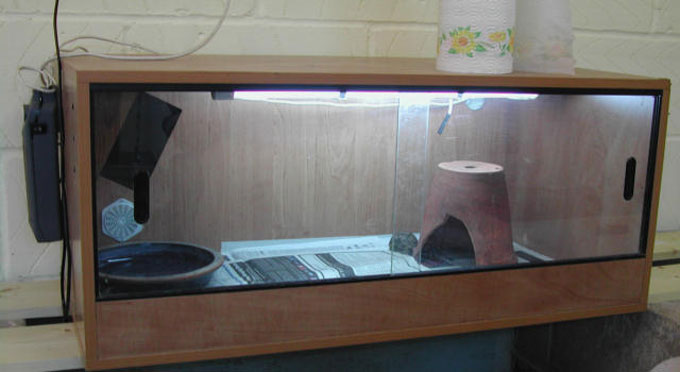
Fig. 1. The vivarium set-up.
In 1995 we moved to a bigger house with a bigger and more secure garden, and this was just as well as my tortoises were growing in size and in number. Our house was getting crowded so we invested in an 8ft square wooden shed (Fig. 2). This was insulated with polystyrene (free offcuts from a local packaging factory) and then the walls and ceiling were covered with wooden cladding. The single glazed windows were covered on the inside with recycled clear plastic to help retain heat. The shed was located on an outside wall of the house to make supplying electricity easier. This enabled me to have the stacked vivaria for the smaller tortoises and open top housing for the larger ones. These open top pens were heated by Pearlco ceramic lamps suspended from the ceiling on chains, connected to Habistat thermostats as before. These were fitted with a reflector and a guard to protect them and reduce the risk of fire from all the newspaper!
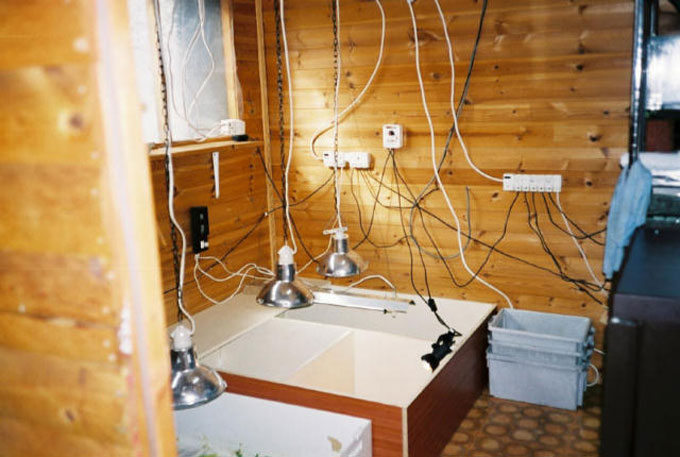
Fig. 2. The shed set-up.
The outdoor quarters went upmarket as well. Five pens were made from treated 6in x 1in timber and the pens are still in use today for the smaller Testudo and the box tortoise. They are 7ft long x 4ft wide, and the 18in high walls are buried 3in below ground (Fig. 3). The far end is enclosed with a small door for access, and has a polycarbonate roof and a shelter inside which is filled with chopped hay (sold as rabbit food). The pens are sited on the south facing side of the garden and are in the dappled shade of an old apple tree for part of the day. Each day during the summer the tortoises have to be transported to the pens if the forecast is for warm sunshine, then put away for the night in their shed. I never leave them out at night due to the risk of attack by foxes that regularly visit the garden.
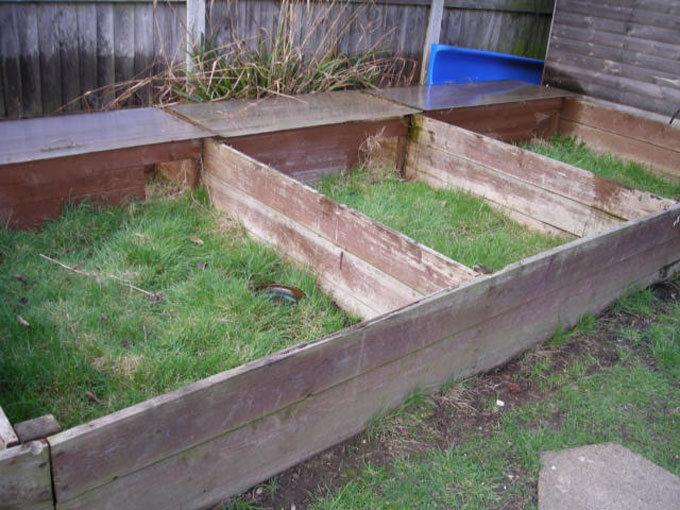
Fig. 3. The wooden tortoise pens.
After five years the sulcatas had outgrown this arrangement, and as they were getting too heavy to carry back and forth I had to have a major rethink about their housing. I decided that they needed a more permanent home and preferably one they could walk into and out of on their own! I employed a builder and in 2003 the breeze block structure of a dedicated tortoise house went up at the bottom of my garden. A channel was dug the whole length of the garden (approximately 120ft) from the tortoise house to carry waste water to the main sewage drain, and this also carries mains water and electricity to the tortoise house. The house has two separate areas each with its own door. On the left side is a pen 8ft wide x 13ft long with a door leading to an outdoor enclosure approximately 20ft by 30ft. The outdoor enclosure is mainly grass with some weeds and the apple tree is in the middle affording some shade (Fig. 4). This is separated from the rest of the garden with planted troughs forming a screen with a gate for access. This large pen houses my three sulcatas and the two larger leopard tortoises (the third is somewhat smaller and rather intimidated by the larger tortoises, so she is kept separately). The large pen is heated by three suspended 250W ceramic heaters in one far corner, which are on a thermostat, and in addition to a UV strip light there is a sun lamp (Power Sun 160W); both of these are on a timed circuit. I did originally have a floor standing oil filled radiator to provide an ambient background heat; however, the tortoises have destroyed all the guards I have put in front of this and so I have had to remove it, and I may get a wall mounted heater so that I can place it out of their reach! During the summer the door to this pen is left open and the tortoises are free to go in and out as they wish. A plastic curtain helps to keep the heat in without impeding the tortoises’ exit.
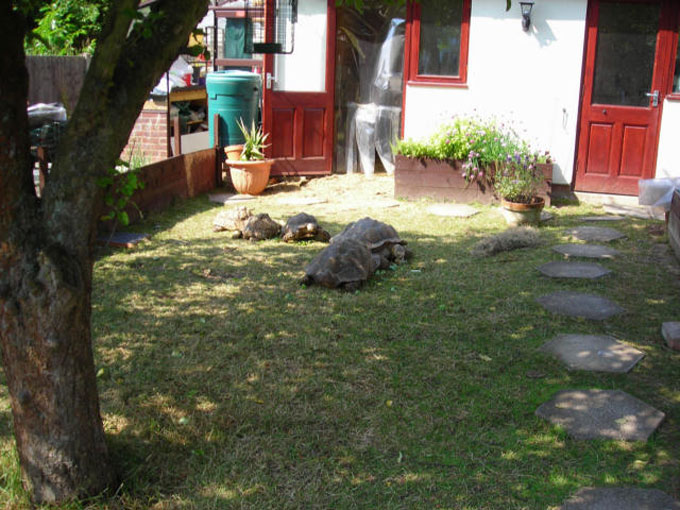
Fig. 4. Sulcatas and leopards in the enclosure.
On the right of the tortoise house the door leads to a utility area complete with sink unit and water heater and a fridge (wine chiller) beneath a work surface. This side of the house also has three 4ft x 6ft pens. Each pen has a shelf with a vivarium on it and these provide a sheltered area beneath (Fig. 5). Each pen and vivarium has a ceramic heater on a separate thermostat and there are strategically placed max/min thermometers throughout the house. The lighting system remains much the same although the timer is now on a central switch. The roof space is insulated and makes a very good storage area. The box tortoise is housed in one of the vivaria as he is able to escape from the pens. I am not sure how he manages this as I have never seen him escape but it just goes to show how determined this particular species is! As he is in an enclosed environment I can use a plant mister to spray the vivarium with water daily to increase the humidity and he has a deeper dish in which to bathe.
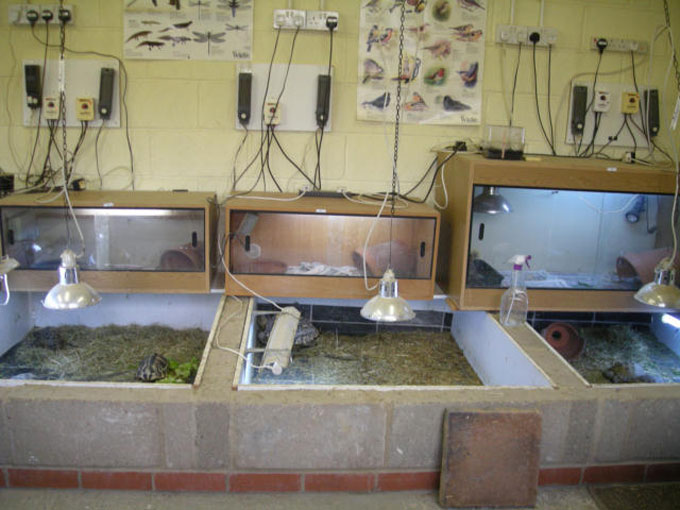
Fig. 5. Inside the tortoise house now.
There were a few problems experienced with the house initially. The floor was painted with a special industrial paint used for garage floors but while it may have been fine to drive over it was no match for tortoise claws and soon the bare concrete floor was showing through! Also the breeze block walls and concrete floor proved not to be good for retaining heat and the pens, heated by suspended ceramic heaters as in the wooden shed, had ‘cold spots’ which the tortoises would hide in. This was rectified by lining the walls with white Melamine which was sealed with silicone sealant. This also made the walls more washable and also helped to ‘bounce’ the light around making it brighter. The floors were lined with linoleum which was purchased cheaply as offcuts from a local carpet store. This is not sealed: as it was so cheap I decided I would replace it as necessary. These alterations have made a big difference to the warmth and also the ease of cleaning of the pens and I hope to do something similar in the big pen although this will have to be on a much bigger scale! One other alteration I would like to make is to include an extractor fan to improve the ventilation.
Adjoining the tortoise house is a greenhouse, originally planned for plants only but even this has been adapted to accommodate tortoises! Two of my large female Testudo graeca live in the greenhouse, which has a brick base to the height of 18in and a dividing polycarbonate ‘wall’ and bubble wrap curtain at the far end to make a warm environment for them (Fig. 6). This is heated and lit as for the tortoise house. I have made a corridor for them to access the door without trampling the plants and they can go in and out as they please during the day but are shut in at night. Their outdoor enclosure is separated from the sulcata enclosure by a wooden partition as described for the wooden tortoise pens.
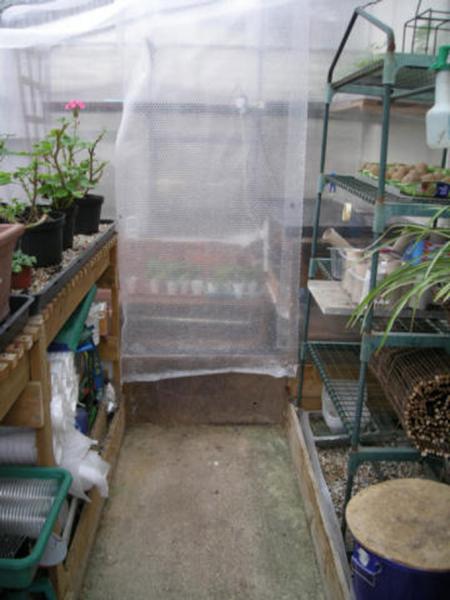
Fig. 6. Greenhouse with partition. The wood is removed to allow the tortoises out.
One thing that hasn’t changed is the diet. I have always fed my tortoises on ‘greenstuff’ once daily mid-morning. The staple diet consists of fresh greens, romaine lettuce, mixed salad leaves and broccoli. These items are torn into large pieces and mixed together in a large plastic container then rinsed in cold water and left wet. In addition to this they get fresh grass clippings and of course weeds in the garden when they are outside. They also occasionally get tomato, cucumber or apple when I have some leftovers from our fridge. The box tortoise also gets slugs and earthworms from the garden and slightly more fruit. I use Nutrobal (VetArk) on every meal and use a pepper shaker to obtain a fine, even dusting over the food.
I hibernate the Mediterranean species once they are over 3in long but I do not hibernate the box tortoise or any of the sulcatas or leopards. Initially I used a double insulated cardboard box for each tortoise. However, I found it difficult to keep the tortoises in hibernation this way as I do not have an area which maintains a constant temperature over the winter months, and so for the past four years I have used a wine- chiller as a hibernaculum. At the end of September/beginning of October I gradually turn down the heaters in the small pens and allow the tortoises to cool down naturally aiming to put them in their hibernation boxes by the beginning of November. I have made wooden boxes that fit the shelves of my tortoise fridge and fill these with shredded paper for insulation. Initially I made dividers for the boxes so each tortoise was separate, but they managed to get through these so I no longer bother and put up to four tortoises in each box. The chiller is set to maintain a temperature of 7°C and this is checked with thermometers on the top and bottom shelf. During the winter the food for the non-hibernating species has to be kept in the greenhouse! I open the door to the fridge daily as it is airtight although I am not sure this is strictly necessary. All being well I bring the tortoises out of hibernation at the end of February by putting them in their inside pens and allowing them to come to room temperature (usually the tortoise house has an ambient temperature of 21°C during the winter months). After a few hours I give them their first bath then turn the heaters on. I find they usually eat on the second day after coming out of hibernation.
I do not worm the tortoises routinely but take a pooled faecal sample from each pen, usually in April, and check this microscopically for worm eggs and treat as necessary before the tortoises go out into their outside pens. As a general rule of thumb if it is warm enough for me to be wearing a T shirt the tortoises go outside during the day, although I do occasionally allow the large sulcatas out if it is cooler but sunny as they need the access to the grass and they can get back in to warm up under the lamps.
My set-up is not perfect and I am constantly striving to improve the living conditions as I am able. However, I feel that what I have achieved in an ordinary suburban back garden is proof that it is possible to keep these species taking into account their individual needs and still have a garden for the humans to relax in and enjoy!
Testudo Volume Seven Number One 2009
Top






